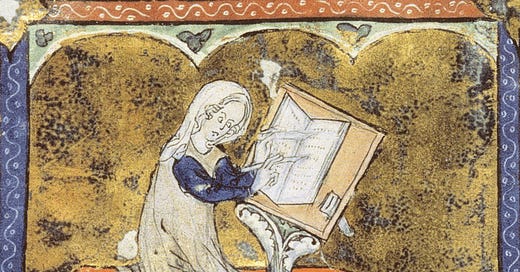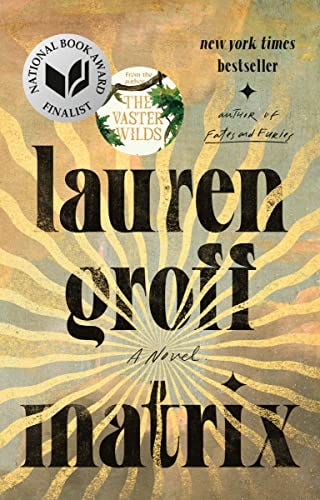(A troubadour song by Bernart de Ventadorn that reputedly influenced one of Marie’s Lais)
In writing my last post about the origins of Saladin, I was reading pretty widely. I’d been googling a bit and stumbled on this article, not exactly sure how I landed there: https://www.esquire.com/entertainment/books/a37397646/who-was-marie-de-france-matrix-lauren-groff/
The article is about Marie de France, the main character in Lauren Groff’s book Matrix. Wait a second, I was reading that book awhile back! But I became sidetracked into something else and did not go back to it to finish…I started it not because of Marie, but because Eleanor of Aquitaine was a character.
It turns out that Marie de France is generally recognized as the first known female poet writing in French. To be clear, she wrote in Anglo-Norman, a French dialect that developed in Norman England, and in fact Marie wrote during the reign of King Henry II. While her precise identity is still the subject of debate, she was clearly of the ruling class, was well-educated and spoke Latin and Anglo-French and possibly other languages; a woman of that day with those language skills was almost certainly noble. It is believed that she lived in England, at least for much of her life. She is also said to have been a member of Henry’s court, or at least to have been known to Henry and Eleanor, although there is some speculation involved. (Groff’s book takes these speculations and weaves a novel around them).
Marie wrote a number of things, but she is best known for her Lais (in English we would say Lays or Songs). Her tales are chivalrous medieval fairy tales, so there are the usual knights and quests and doomed romances and such, but her female characters are strong and have agency; they aren’t just pawns of men in the game of courtly romance and are often the driver of events. There is a good deal of magic; ships with no crew that sail themselves, werewolves (!), knights that shapeshift from hawks back to people. In these stories it is easy to see Marie as the precursor to Chrétien de Troyes, Wolfram von Eschenbach, and other writers of chivalrous King Arthur tales.
The stories exist in many translations, including a public domain version on Project Gutenberg (which is readable but not especially well formatted for eReaders), and more recent/modern translations such as those of Claire Waters or Katharine Margot Toohey. I am in process of producing a free edition for Standard Ebooks based on the Project Gutenberg version translated by Eugene Mason.
I cracked open a copy, and read The Lay of Yonec, in which the knight transforms himself to a hawk to fly to where a lady is imprisoned. Interesting. Checked out the table of contents, and saw included after the Lais, something called “A Story of Beyond the Sea”—hmm, that rings a bell. Maybe it’s a story of Outremer, (French for ‘Beyond the Sea’, the French name for the overseas Crusader Kingdom in the Holy Land). I start reading, and yes, it is, sort of. Brief spoiler, that takes us to the point of the article: a noble couple in France are having trouble conceiving a child, and after a series of adventures and misadventures, the woman ends up in the Holy Land married to a Saracen. The last line of the story <SPOILER ALERT>:
For of this lady, who was called the Fair Captive, was born the mother of that courteous Turk, the Sultan Saladin, an honourable, a wise, and a conquering lord.
In this story, Saladin’s grandmother was a French noble. And as this story indicates, at the time of its writing, Saladin was already known by westerners and thought to be wise, honorable, and so on…the “chivalrous” Saladin. The dates of Marie’s writing are not precise, but it is usually pegged to the 1170s, in any case during Henry’s reign, so it is likely that Richard the Lionheart knew these stories, and therefore of Saladin, perhaps even during his youth. (To be fair, this story is included in a collection of Lais by Marie, but more modern scholarship does not attribute this story to Marie).
There are many legends that grew around Saladin in Europe, many of them preposterous: Saladin and Eleanor were lovers (Saladin would have been around 10 when Eleanor came to the Holy Land); Saladin tries to convert to Christianity and become a knight; Saladin spoke French and Latin; Saladin traveled around Europe, Saladin married a Christian noblewoman, and so on.12
It is also hard to overstate the impact of the books of Sir Walter Scott, especially The Talisman and Ivanhoe, on the western imaginative conception of Saladin. These books contain their own interesting Saladin legends, include the one where Saladin attends to Richard in disguise as a physician when Richard is ill.
Saladin and Richard both captured the imaginations of people in their own era, and through until today, so it is not surprising that stories sprung up around them. Think of them as an early era “fanfic” :)
The Life and Legend of Saladin, Jonathan Phillips.
https://www.academia.edu/1496191/The_Evolution_of_the_Saladin_Legend_in_the_West







